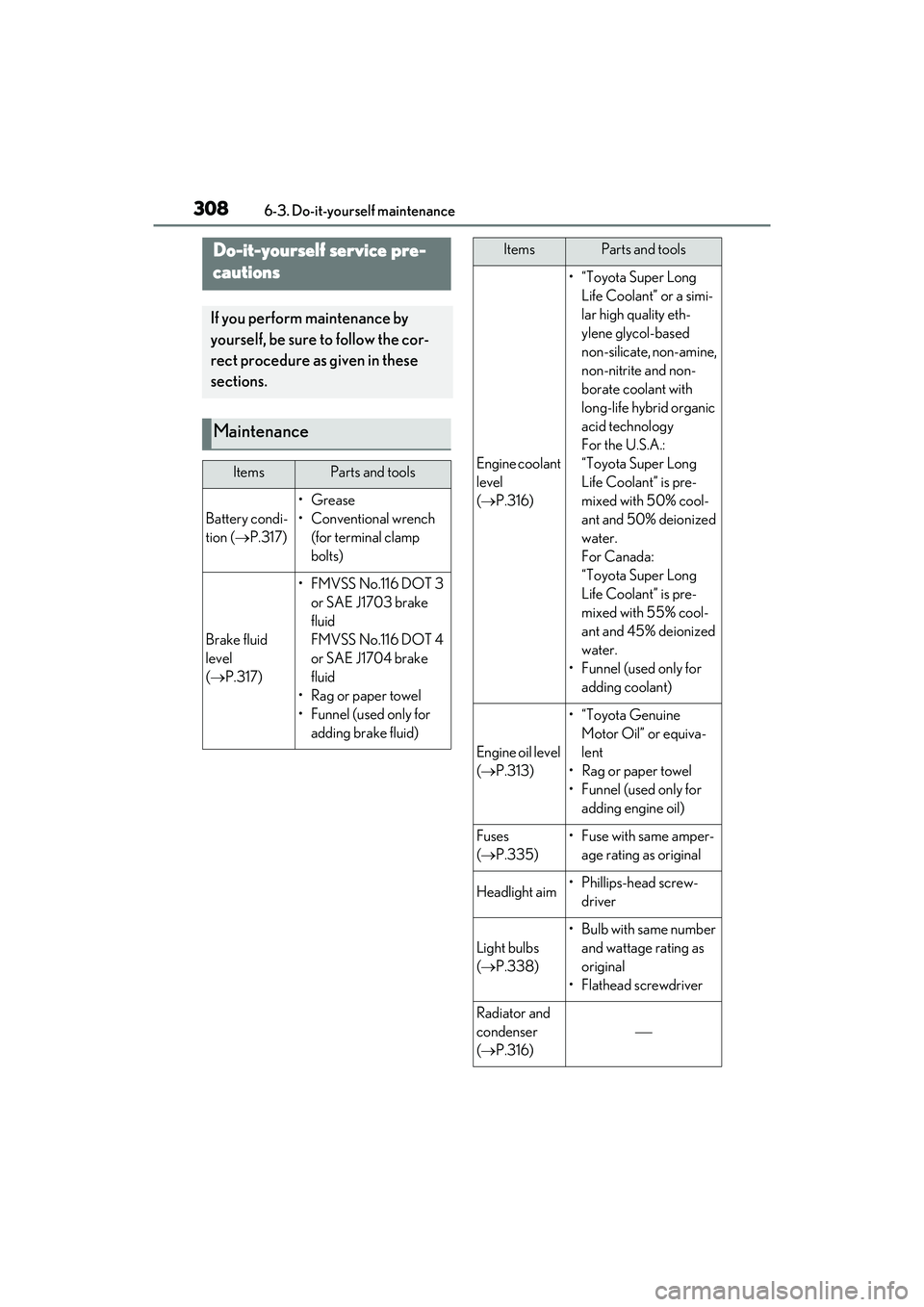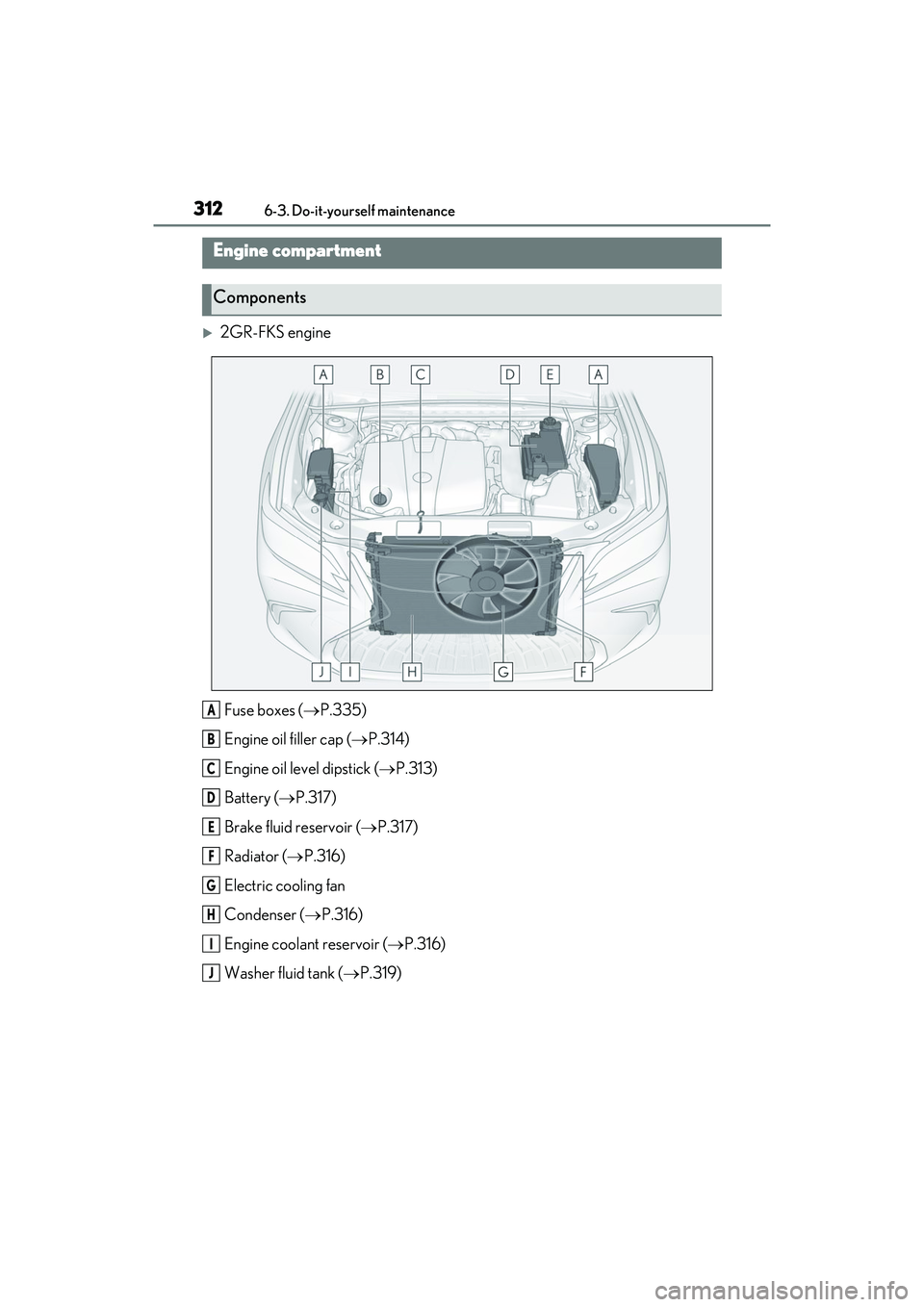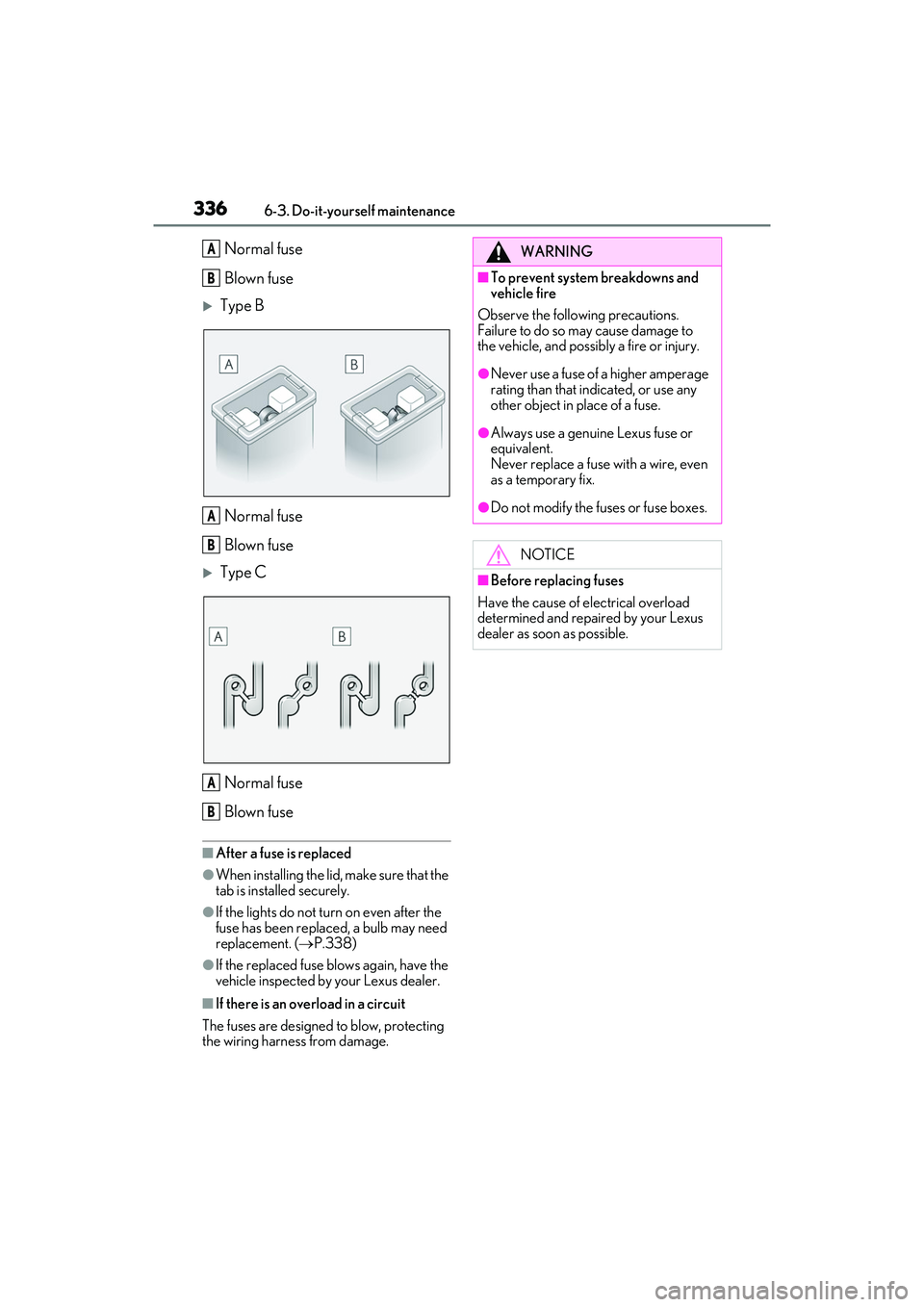2022 LEXUS ES350 fuse
[x] Cancel search: fusePage 6 of 468

4TABLE OF CONTENTS
6-3. Do-it-yourself maintenanceDo-it-yourself service precautions........................................................... 308
Hood................................................... 310
Positioning a floor jack ................ 310
Engine compartment................... 312
Tires ................................................... 320
Tire inflation pressure ................. 328
Wheels.............................................. 330
Air conditioning filter................... 331
Electronic key battery ................ 333
Checking and replacing fuses 335
Headlight aim................................. 337
Light bulbs ....................................... 338
7-1. Essential information Emergency flashers..................... 344
If your vehicle has to be stopped in an emergency ............................. 344
If the vehicle is submerged or water on the road is rising .................. 345
7-2. Steps to take in an emergency If your vehicle needs to be towed........................................................... 347
If you think something is wrong ........................................................... 349
Fuel pump shut off system ........ 350
If a warning light turns on or a warning buzzer sounds ........... 351
If a warning message is displayed ............................................................ 361
If you have a flat tire..................... 365
If the engine will not start .......... 374
If you lose your keys .................... 375If the fuel filler door cannot be
opened .......................................... 376
If the electronic key does not oper- ate properly ................................. 376
If the battery is discharged ....... 379
If your vehicle overheats ........... 382
If the vehicle becomes stuck ... 385
8-1. Specifications Maintenance data (fuel, oil level, etc.) ................................................. 388
Fuel information............................ 397
Tire information ............................ 399
8-2. Customization Customizable features .............. 408
8-3. Items to initialize Items to initialize ............................ 419
9-1. For owners Reporting safety defects for U.S. owners ............................................ 422
Reporting safety defects for Cana- dian owners .................................. 422
Seat belt instructions for Canadian owners (in French) ................... 423
SRS airbag instructions for Cana- dian owners (in French) .......... 424
Headlight aim instructions for Canadian owners (in French)
.......................................................... 430
7When trouble arises
8Vehicle specifications
9For owners
Page 299 of 468

297
6
6
Maintenance and care
Maintenance and care
6-1. Maintenance and careCleaning and protecting the vehi-cle exterior ................................ 298
Cleaning and protecting the vehi- cle interior .................................. 301
6-2. Maintenance Maintenance requirements .. 303
General maintenance ............. 304
Emission inspection and mainte- nance (I/M) programs ......... 307
6-3. Do-it-yourself maintenance Do-it-yourself service precautions ............................... 308
Hood................................................ 310
Positioning a floor jack ............. 310
Engine compartment................ 312
Tires ................................................ 320
Tire inflation pressure .............. 328
Wheels........................................... 330
Air conditioning filter................ 331
Electronic key battery ............. 333
Checking and replacing fuses ........................................................ 335
Headlight aim.............................. 337
Light bulbs .................................... 338
Page 301 of 468

2996-1. Maintenance and care
6
Maintenance and care
parking in hot weather
■Brake pads and calipers
Rust may form if the vehicle is parked with
wet brake pads or disc rotors, causing them
to stick. Before parking the vehicle after it is
washed, drive slowly and apply the brakes
several times to dry the parts.
■Bumpers
Do not scrub with abrasive cleaners.
■Front side windows water-repellent
coating
●The following precautions can extend the
effectiveness of the water-repellent coat-
ing.
• Remove any dirt, etc. from the front side
windows regularly.
• Do not allow dirt and dust to accumulate on the windows for a long period.
Clean the windows with a soft, damp
cloth as soon as possible.
• Do not use wax or glass cleaners that
contain abrasives when cleaning the win-
dows.
• Do not use any metallic objects to
remove condensation build up.
●When the water-repellent performance
has become insufficient, the coating can
be repaired. Contact your Lexus dealer.
■Plated portions
If dirt cannot be removed, clean the parts as
follows:
●Use a soft cloth dampened with an
approximately 5% solution of neutral
detergent and water to clean the dirt off.
●Wipe the surface with a dry, soft cloth to
remove any remaining moisture.
●To remove oily deposits, use alcohol wet
wipes or a similar product.
WARNING
■When washing the vehicle
Do not apply water to the inside of the
engine compartment. Doing so may
cause the electrical components etc. to
catch fire.
■When cleaning the windshield (vehi-
cles with rain-sensing windshield wip-
ers)
Set the wiper switch to off.
If the wiper switch is in “AUTO”, the wip-
ers may operate unexpectedly in the fol-
lowing situations, and may result in hands
being caught or other serious injuries
and cause damage to the wiper blades.
Off
AUTO
●When the upper part of the windshield
where the raindrop sensor is located is
touched by hand
●When a wet rag or similar is held close
to the raindrop sensor
●If something bumps against the wind-
shield
●If you directly touch the raindrop sen-
sor body or if something bumps into
the raindrop sensor
■Precautions regarding the exhaust
pipes and rear bumper diffusers (if
equipped)
As exhaust gases cause the exhaust
pipes and rear bumper diffusers to
become quite hot, do not touch the
exhaust pipes and rear bumper diffusers
while the engine is running or immedi-
ately after the engine is turned off.
When washing the vehicle, be careful not
to touch the exhaust pipes and rear
bumper diffusers until they have cooled
sufficiently, as touching hot exhaust pipes
and rear bumper diffusers can cause
burns.
A
B
Page 310 of 468

3086-3. Do-it-yourself maintenance
6-3.Do-it-yo urself mainte nance
Do-it-yourself service pre-
cautions
If you perform maintenance by
yourself, be sure to follow the cor-
rect procedure as given in these
sections.
Maintenance
ItemsParts and tools
Battery condi-
tion (P.317)
•Grease
• Conventional wrench
(for terminal clamp
bolts)
Brake fluid
level
( P.317)
• FMVSS No.116 DOT 3
or SAE J1703 brake
fluid
FMVSS No.116 DOT 4
or SAE J1704 brake
fluid
•Rag or paper towel
• Funnel (used only for adding brake fluid)
Engine coolant
level
( P.316)
•“Toyota Super Long
Life Coolant” or a simi-
lar high quality eth-
ylene glycol-based
non-silicate, non-amine,
non-nitrite and non-
borate coolant with
long-life hybrid organic
acid technology
For the U.S.A.:
“Toyota Super Long
Life Coolant” is pre-
mixed with 50% cool-
ant and 50% deionized
water.
For Canada:
“Toyota Super Long
Life Coolant” is pre-
mixed with 55% cool-
ant and 45% deionized
water.
• Funnel (used only for adding coolant)
Engine oil level
( P.313)
•“Toyota Genuine
Motor Oil” or equiva-
lent
• Rag or paper towel
• Funnel (used only for adding engine oil)
Fuses
( P.335)• Fuse with same amper-
age rating as original
Headlight aim• Phillips-head screw-driver
Light bulbs
( P.338)
• Bulb with same number
and wattage rating as
original
• Flathead screwdriver
Radiator and
condenser
( P.316)
ItemsParts and tools
Page 314 of 468

3126-3. Do-it-yourself maintenance
2GR-FKS engineFuse boxes ( P.335)
Engine oil filler cap ( P.314)
Engine oil level dipstick ( P.313)
Battery ( P.317)
Brake fluid reservoir ( P.317)
Radiator ( P.316)
Electric cooling fan
Condenser ( P.316)
Engine coolant reservoir ( P.316)
Washer fluid tank ( P.319)
Engine compartment
Components
A
B
C
D
E
F
G
H
I
J
Page 315 of 468

3136-3. Do-it-yourself maintenance
6
Maintenance and care
A25A-FKS engineFuse boxes ( P.335)
Engine oil filler cap ( P.314)
Engine oil level dipstick ( P.313)
Battery ( P.317)
Brake fluid reservoir ( P.317)
Radiator ( P.316)
Electric cooling fan
Condenser ( P.316)
Engine coolant reservoir ( P.316)
Washer fluid tank ( P.319)
With the engine at operating tempera-
ture and turned off, check the oil level
on the dipstick.
■Checking the engine oil
1 Park the vehicle on level ground.
After warming up the en gine and turning it
off, wait more than 5 minutes for the oil to
drain back into the bottom of the engine.
2 Holding a rag under the end, pull
the dipstick out.
A
B
C
D
E
F
G
H
I
J
Checking and adding the engine
oil
Page 337 of 468

3356-3. Do-it-yourself maintenance
6
Maintenance and care
1Turn the engine switch off.
2 Open the Fuse box cover.
Engine compartment: type A fuse
box
Push the tab in and lift the lid off.
Engine compartment: type B fuse
box
Push the tab in and lift the lid off.
Driver’s side instrument panel
Push the tab in and remove the lid. Make sure to push the tab in during
removal or installation.
3
Remove the fuse with the pullout
tool.
Only type A fuses can be removed using
the pullout tool.
4Check if the fuse is blown.
Type A and B:
Replace the blown fuse with a new fuse of
an appropriate amperage rating. The
amperage rating can be found on the fuse
box lid.
Type C:
Contact your Lexus dealer.
Type A
Checking and replacing
fuses
If any of the electrical components
do not operate, a fuse may have
blown. If this happens, check and
replace the fuses as necessary.
Checking and replacing fuses
Page 338 of 468

3366-3. Do-it-yourself maintenance
Normal fuse
Blown fuse
Type BNormal fuse
Blown fuse
Type CNormal fuse
Blown fuse
■After a fuse is replaced
●When installing the lid, make sure that the
tab is installed securely.
●If the lights do not turn on even after the
fuse has been replaced, a bulb may need
replacement. ( P.338)
●If the replaced fuse blows again, have the
vehicle inspected by your Lexus dealer.
■If there is an overload in a circuit
The fuses are designed to blow, protecting
the wiring harness from damage.
A
B
A
B
A
B
WARNING
■To prevent system breakdowns and
vehicle fire
Observe the following precautions.
Failure to do so may cause damage to
the vehicle, and possibly a fire or injury.
●Never use a fuse of a higher amperage
rating than that indicated, or use any
other object in place of a fuse.
●Always use a genuine Lexus fuse or
equivalent.
Never replace a fuse with a wire, even
as a temporary fix.
●Do not modify the fuses or fuse boxes.
NOTICE
■Before replacing fuses
Have the cause of electrical overload
determined and repaired by your Lexus
dealer as soon as possible.